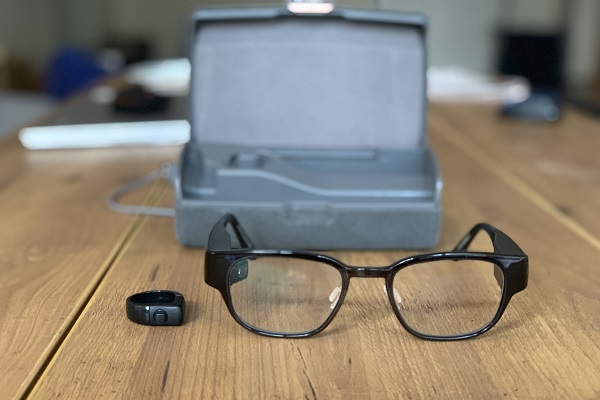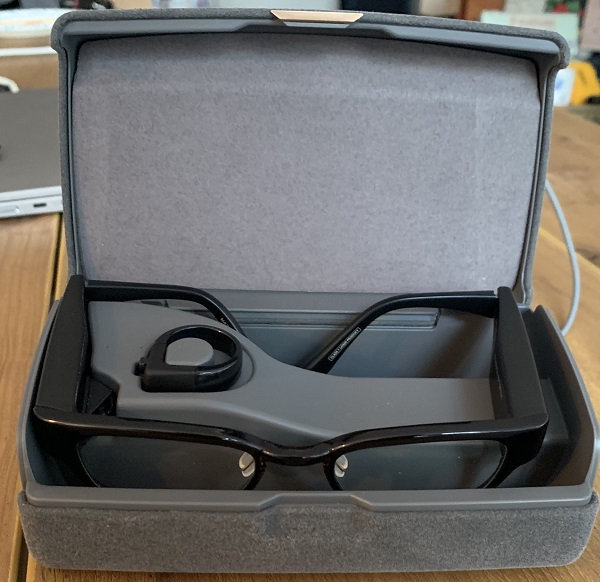Review: North Focals Clarify a Vision of Smart Glasses

- North Focals are smart glasses designed to look like a standard pair of spectacles and controlled by a ring joystick called a Loop
- Amazon Alexa is built into the glasses, which include small microphone and speaker
- Acts like a more discreet smartwatch with a small stable of built-in functions and a growing stable of third-party apps
- Far more practical and stylish than Google Glass or competitor smart glasses, but still too limited to be worth the $600 cost except to early adopters
Smart glasses suffer from what might be called the Glasshole effect. Even as checking email on a smartwatch or walking around with true wireless earphones in all day becomes a common sight, obvious technology in eyewear can be disconcerting when it comes to wearable technology. Focals by North are a line of smart glasses clearly aimed at curing that stigma.
Hidden Tech in High Fashion
First released last fall by Canadian startup North, Focals at first glance look like a nice pair of normal glasses. Unless someone is paying close attention, they may not even notice the battery, speaker, color laser, and other tech built into them. It is worth noting that the Focals experience isn’t limited to the glasses. Each pair also comes with a slightly glossy black ring, called a Loop, that you use to access certain features without the need to speak or touch the eyewear.
From my point of view, the glasses are comfortable, if slightly heavy on my face. A small section of the right lens lights up with a holographic welcome and a soft chime from the speakers in the earpieces when I press down with my thumb on the mini-joystick on the Loop ring positioned on my right index finger.
There are Some Apps for That, And Alexa
The image floating in front of with the current time doesn’t obscure my vision, and it’s easy to focus past it if I choose. Likewise, the sound can be adjusted or turned off with a swipe and a couple of clicks with the Loop joystick. The first visual tab also includes notifications from my iPhone. Much like most smartwatches, the glasses are largely an extension of a phone, connected by Bluetooth to a mobile app.
Swiping with the joystick takes me through weather, messaging, navigation, and other built-in apps. A quiz game, language flashcard test, and the ability to call an Uber are all part of the initial line-up of tools. There are also optional connections to Twitter, Slack, Spotify, and a growing list of other third-party applications, including most of Google’s office apps. Holding down the joystick button awakens the Amazon Alexa voice assistant in the glasses, which can be used much like an Echo smart speaker, within the limitations of the glasses.

I could use Alexa to look up information or run audio-based skills, but it took some experimentation to figure out what could be done. The hardware performed remarkably well, however, with no misunderstandings by Alexa except when it was already very loud around me, and I similarly had no problem hearing the responses, though the higher volume was necessary when walking near a construction site. The sound is audible to people nearby, but only barely so at the lower levels, so it’s easy to use the apps that don’t require speaking without anyone noticing. The messaging app includes a few pre-generated responses so even that aspect doesn’t necessarily require speaking out loud.
The turn-by-turn directions North partnered with Mapbox to build into the Focals was immensely appealing to me as someone who always gets lost without frequent Google Maps checks. There weren’t any obvious misdirections in my tests, and the helpful arrows and distances appearing in front of my eyes made a nice change from pulling out my phone every other block. Using Alexa, I could even ask for directions to nearby stores and other locations.
However, there are several limitations to the Focals, especially if you use an iPhone as I do. As a non-Apple product, Focals can’t use iMessage. Instead, when dictating messages, it sends them to a North server and the recipient gets a message from an entirely new number and on a new message thread. An automated message explains to whoever I text that the message is coming from my smart glasses, but I still needed to explain it myself. It was annoying enough that I soon limited my texting via the glasses to just a few people.
Tailored Wearables for Individuals
While the glasses sometimes struggled to assist me, the people working at the North storefront in Brooklyn were great during the somewhat extended process of getting the Focals in the first place. There’s no online purchasing, customers have to go to either the Toronto or Brooklyn storefronts. The Brooklyn shop looks like an Apple Store with more wood tones. The first visit is like going to the eye doctor, albeit one who takes a 3D photo of your face to fit you for your glasses.
At the moment North offers three color patterns and two shape choices for the glasses. The standard package costs $600, and the special shape and colors cost an additional $100. There’s also an option to get prescription lenses for an extra $200, although that can usually be covered by insurance.
A month or so after the first visit, there’s a final fitting appointment where the associates run you through the setup process and check that it’s easy to view the hologram displayed on the lens. My colleague who has tried these glasses assures me that without the fitting, the Focals display is hard to get into the field of view and nearly impossible to maintain. It is a digital user experience that requires a precise analog fitting.
Physical Limits

The included carrying case for the glasses and ring also plugs into a wall or USB port to charge their batteries. The glasses last for about a day of continuous use, the Loop ring another day or two before being drained. It’s easy enough to check how much charge they have left using the glasses, but the case is too bulky to fit in a pocket, so it’s necessary to make sure you can charge the devices at night.
The image on the lens also relies on contrast to work, so if there’s too much light, it becomes all but invisible. A set of clip-on sunglasses included with the purchase can make it possible to see the image again, but it’s not a perfect fix.
Connected and in the Moment, in a Few Years
Focals by North set a high standard for consumer smart glasses, and there is a lot to like about their capabilities. That said, it may take one or two more iterations for them to hit the point in use and comfort where people buy them as casually as they buy smartwatches.
The combination of vocal and tactile input is a very clever way to give the devices a comfortable conversational input, yet keep the option for fast, and subtle use when speaking isn’t necessary or possible. I tended to use the ring by default but didn’t have any trouble switching to voice to interact with Alexa or dictate messages as needed. The two complement each other nicely. And, while the glasses aren’t quite as flexible as a current smartwatch, North is pumping out new apps almost every other week. Just in the time I tested them they rolled out the Slack connection and added the ability to identify songs played around you. The fact that people who didn’t know I was wearing smart glasses occasionally complimented me for my stylish frames also earns Focals a few points.
But, for all the great aspects of Focals by North, they still feel like a work in progress. Most of the new apps and features are labeled as ‘experiments’ and the company solicits as much feedback as possible to keep iterating on the product. That’s not bad in and of itself, but it does restrict likely users to those willing to be a guinea pig. The next version of the glasses, or the one after that, with all of the attendant improvements in software and features, might have broader appeal, but it’s not quite there yet.
The company would appear to have the resources to make these investments. Pitchbook data show that it has raised over $200 million from the likes of Intel Capital, Fidelity Investments, Spark Capital, and the Amazon Alexa Fund. North also snagged a $24 million grant from the Government of Canada in the fall of 2018. It also has a growing intellectual property portfolio which includes patents it acquired from Intel that were previously used in the since shuttered Vuant smart glasses product.
With that said, technology and funding alone won’t be sufficient for success in this category. Social acceptance will be as critical as flawless features in this category. Smartwatches have many similar features but don’t suffer from the “Glasshole effect.” The smartwatch comparison is almost certainly going to be one all smart glasses will confront unless they are like the new Bose Frames smart glasses, which have no visual element at all and blur into the hearables category. Like a smartwatch, wearing Focals by North led me to check my phone less frequently while not worrying about missing incoming messages or needing to check my location.
For $600, you probably don’t need Focals by North, but if you want access to the leading edge of smart glasses development, they’re a great option. That I look sophisticated wearing them is just a bonus.
Follow @voicebotai Follow @erichschwartz








